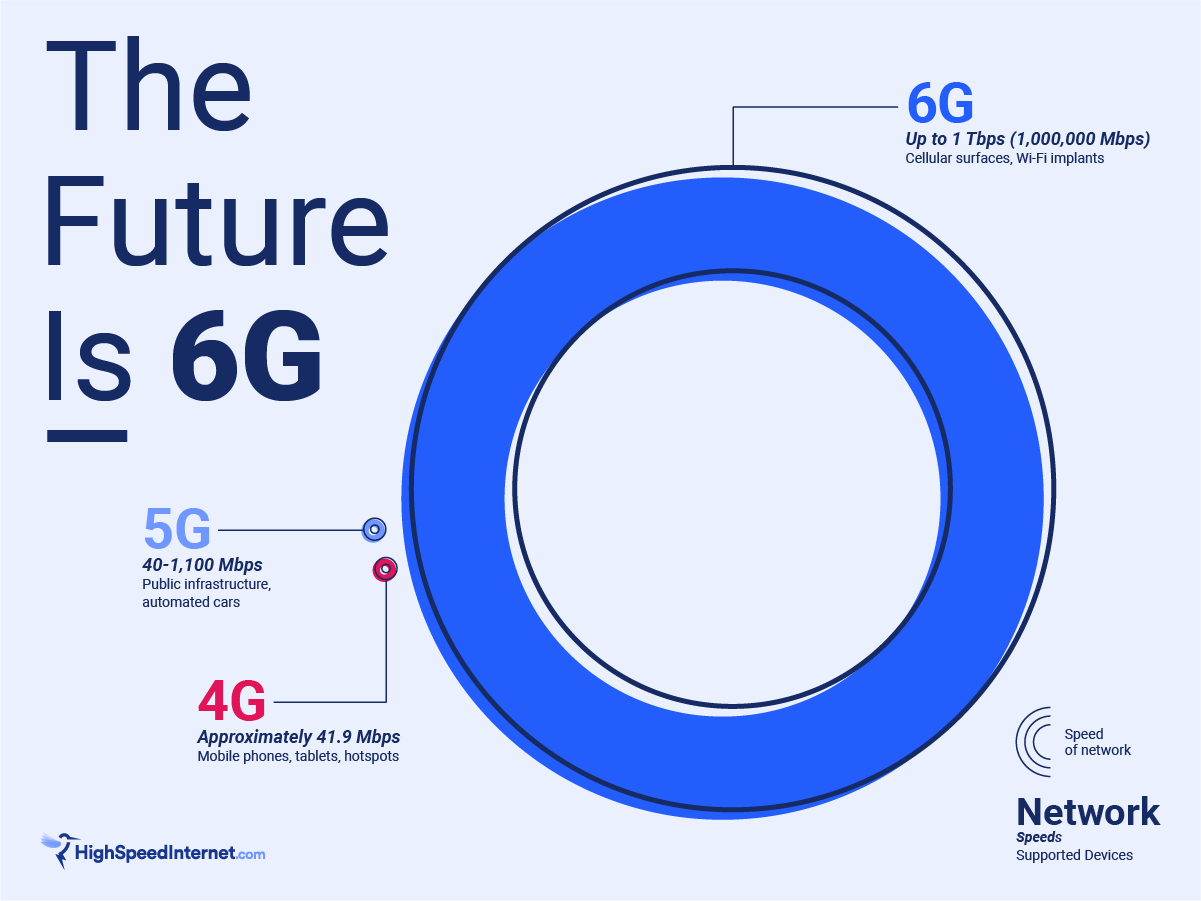How Powerful Is 6G?
6G is the next generation of mobile communication technology, and its potential is vast. 6G is expected to deliver a massive increase in speed, capacity, and latency, as well as enable new applications and services never before possible. With its tremendous speed and capacity, 6G could revolutionize how we communicate, shop, work, and play. It could even enable us to explore new frontiers in the physical world, such as the Internet of Things, smart cities, and driverless cars. Its potential is so great that it could be as revolutionary as the internet itself was in the early 1990s. With 6G, we could be entering a whole new era of communication and technology.
Overview of 6G
As technology advances, the need for faster and more reliable communication increases. 6G is the sixth-generation wireless technology, and it promises to revolutionize the way we interact with the world and access the internet. 6G is expected to provide significantly faster speeds than 5G, as well as offer ultra-low latency and advanced features such as extended reality and 3D audio.
In terms of speeds, 6G is set to provide speeds of 1Tbp/s, a significant improvement over 5G’s maximum speed of 20Gbp/s. This increased speed will enable users to access 4K and 8K videos without buffering, download large files in seconds, and make use of advanced technologies such as autonomous vehicles, virtual reality, and the Internet of Things.
Latency is also expected to be drastically reduced with 6G. While 5G networks have a latency of around 1ms, 6G is predicted to be around 0.001ms. This ultra-low latency will make it possible for users to experience real-time communication and interact with augmented and virtual reality environments with minimal delays.
In addition to faster speeds and lower latency, 6G will also utilize advanced technologies such as Artificial Intelligence and blockchain to improve the overall user experience. AI will be used to enhance data security and optimize network performance, while blockchain will help manage the data traffic on the network.
Although 6G is still in its infancy, there is no doubt that it will revolutionize the way we communicate and access information. With its ultra-high speeds, ultra-low latency, and advanced features, 6G is sure to be the future of wireless technology.
History of Wireless Technology
The world of technology has seen an incredible evolution in the past few decades. From the early days of wired communication to the birth of wireless communications, technology continues to advance at a rapid pace. Today, we are on the cusp of the next wireless revolution, 6G. But before we can explore the power of 6G, it is important to understand the history of wireless technology and how it has evolved.
Wireless communications have been around for a while. The first wireless telegraphs were developed in the late 19th century and were used to send Morse code signals. This was followed by the invention of the radio in the early 20th century. Radio technology was used to transmit voice and data signals, and it was the foundation of the modern wireless communication systems.
In the 1940s, the first mobile phones were developed. These early mobile phones were bulky and expensive, but they allowed for the transmission of voice signals over a cellular network. This paved the way for the development of the first commercially available cellular networks in the 1980s. Since then, cellular networks have evolved significantly, leading to the development of 3G, 4G, and now 5G networks.
Now, the world is on the cusp of a new wireless revolution. 6G is set to revolutionize the way we communicate and connect with the world. With its promise of extremely high speeds and low latency, 6G promises to revolutionize the way we interact with technology in the future.
Advantages of 6G
Technology
As the world continues to evolve and technology advances, 6G technology is being heralded as the next major wave of technological innovation. 6G technology is expected to offer businesses and consumers around the world the ability to communicate and transact quickly and securely. This new technology has the potential to revolutionize the way we use our devices and access information, creating a much more efficient and cost-effective way of living.
The main advantage of 6G technology is its speed and data transfer capacity. This technology is set to increase the speed of data transfer by up to 100 times faster than the current 5G speeds. It will also be able to handle more data at once, allowing for larger files to be processed and transferred quickly and easily. This will open up many possibilities for businesses and consumers, such as being able to access large files and data sets without having to wait for them to be downloaded and processed.
Another advantage of 6G technology is its ability to provide enhanced security measures. This technology is expected to be more secure than current wireless networks, as it uses a much more advanced encryption system. This will protect users from hackers and malicious actors, ensuring that their data is safe and secure.
In addition, 6G technology has the potential to provide a more reliable connection. This technology is expected to provide a higher quality of service, with improved latency and fewer dropped connections. This will allow users to connect to the internet more easily and quickly, providing them with a more reliable way to access online services.
These are just some of the advantages of 6G technology, and it is clear that this technology has the potential to transform how we use our devices and access information. Businesses and consumers alike can benefit from this technology, and the possibilities for the future are exciting.

Challenges Facing 6G
With 5G technology still in its infancy, conversations have already begun about the potential of 6G. 6G technology promises to be up to 100 times faster than 5G and will be capable of providing speeds up to 1 terabit per second, with latency of 1 millisecond. Despite the extraordinary potential of 6G, there are still several challenges that must be addressed before the technology can be widely adopted.
First, 6G technology will require far greater bandwidth than its predecessors, so communication networks must be equipped to handle the increased demand. This means that new communication infrastructure will have to be built, including base stations and data centers. This will require a significant financial investment from the telecom industry.
Second, as 6G technology will rely heavily on artificial intelligence and machine learning, the processing power required to handle the data will be immense. This could lead to issues such as latency and slow data speeds, which could be a significant barrier to adoption.
Finally, the security implications of 6G technology must be considered. As 6G technology will allow for the transmission of large amounts of data at high speeds, it could be vulnerable to cyber-attacks. To ensure the security of 6G networks, robust security protocols will need to be in place.
Although many challenges still remain, the potential of 6G technology is incredibly exciting and could revolutionize the way we connect with each other, access information, and interact with the world around us.
Applications of 6G
technology are expected to revolutionize the way we live and conduct business. 6G technology is the next generation of cellular technology after 5G, promising faster speeds, better coverage, and lower latency, as well as new features and capabilities. This new technology will be capable of connecting more devices, providing greater bandwidth and higher data rates, and utilizing higher frequencies. 6G will also bring new opportunities to the Internet of Things (IoT), allowing for the development of smarter cities, autonomous vehicles, and more. 6G will also enable the use of artificial intelligence, virtual reality, and augmented reality on a much larger scale. 6G technology will be used to provide increased security for applications and data, as well as improved communications for public safety. With 6G, businesses will be able to create innovative solutions to address challenges and capitalize on opportunities. 6G technology will also provide opportunities to create new products and services, and increase operational efficiency. From enhanced gaming experiences to improved customer service, 6G promises to transform the way we live and work. With its potential to revolutionize the way we connect, it’s clear that 6G is a powerful technology that has the potential to shape the future of the digital age.
Future of 6G
The next generation of mobile networks, 6G, is expected to be the most powerful and advanced yet. 6G promises to revolutionize the way we communicate and interact with the world, offering unprecedented data transfer speeds and enabling new applications and services. 6G is expected to have the potential to deliver data speeds of up to 10Gbps, which is almost 100 times faster than current 5G networks. In addition, 6G networks are expected to offer ultra-low latency and provide more reliable coverage in areas where other networks may be unreliable.
This ultra-high-speed connectivity opens up a world of opportunities and possibilities. It can enable improved virtual reality and augmented reality experiences, offer faster download speeds and buffer-free streaming, and make it possible to access cloud-based services in real-time. It could also provide a powerful platform for machine learning and artificial intelligence, allowing for faster and more accurate predictions to be made.
The potential of 6G networks is immense, and it seems inevitable that it will eventually be adopted. 6G networks are expected to become commercially available in the coming years, and it is likely to have a huge impact on the way we use technology. It is clear that 6G is set to be an incredibly powerful and transformative technology, and its effects are likely to be felt in a variety of industries.
FAQs About the How Powerful Is 6G?
1. What Frequency Will 6G Operate On?
6G is expected to operate on frequencies above 100GHz, with some studies suggesting they could reach up to 1THz.
2. How Fast Will 6G Be Compared to 5G?
6G is expected to deliver speeds up to 100 times faster than 5G, with some estimates reaching up to 1 terabit per second.
3. When Will 6G Be Available?
It is estimated that 6G will not be available until 2030 or later.
Conclusion
In conclusion, 6G technology is sure to be powerful. It promises to bring faster speeds, better security, and improved connection stability. 6G also has the potential to revolutionize the way we interact with the internet, allowing us to access new levels of data and interact with the world in new ways. As the technology continues to develop, it is sure to become even more powerful and capable of transforming our lives.




